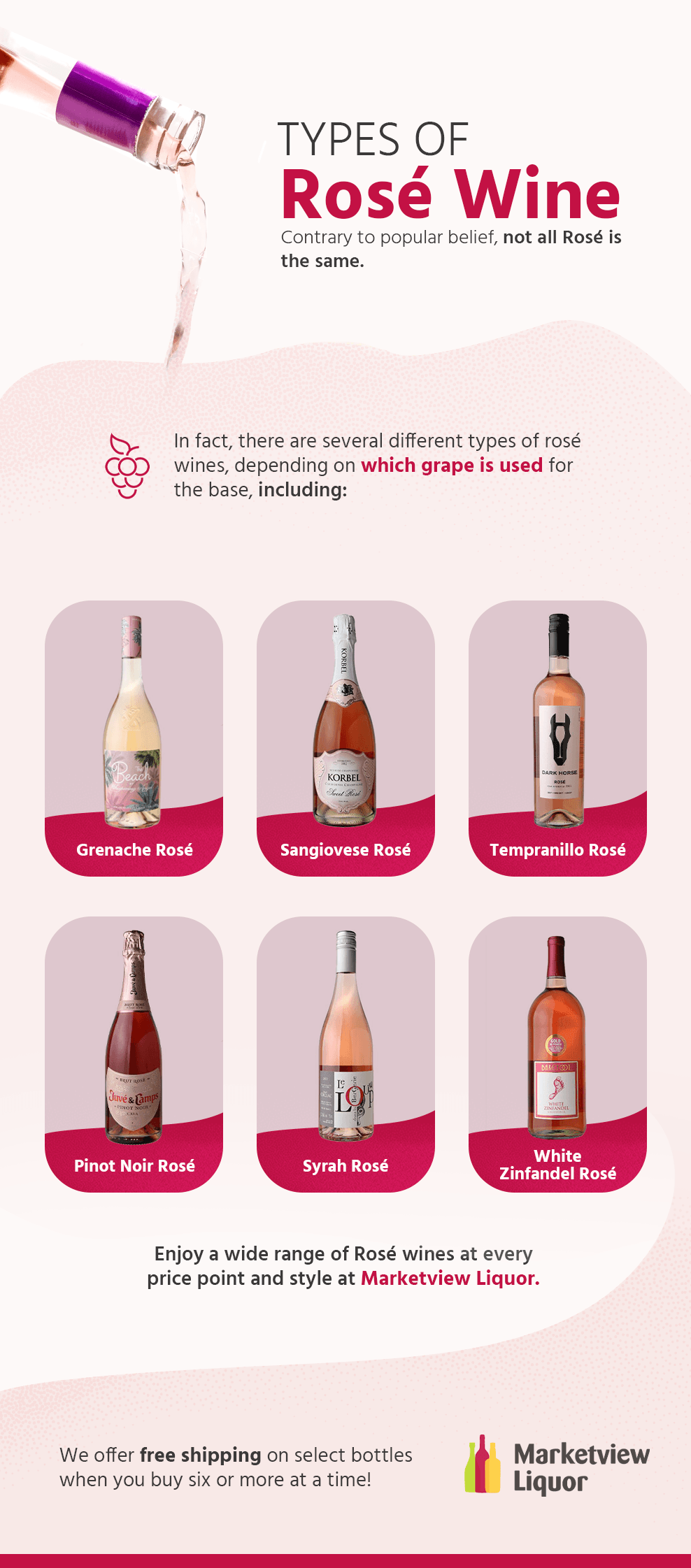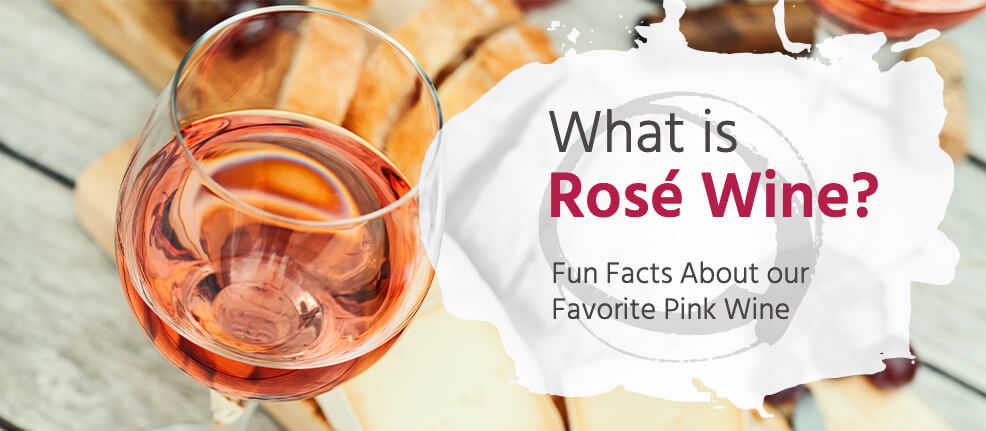
Rosé has been blowing up in popularity as of late — this often misunderstood and previously underappreciated pink wine has enjoyed mentions in rap songs and other media over the past few years. It’s even become something of an Instagram star and summertime staple thanks to its current status as a millennial fave. It’s affordable, refreshing and surprisingly sophisticated. Food-friendly and approachable, it’s just as good on its own as it is when paired with salmon – making it an easy choice, especially in warm weather.
Here is everything you need to know about how Rosé wine is made, what it tastes like and even a few of our favorite Rosé-inspired cocktails.
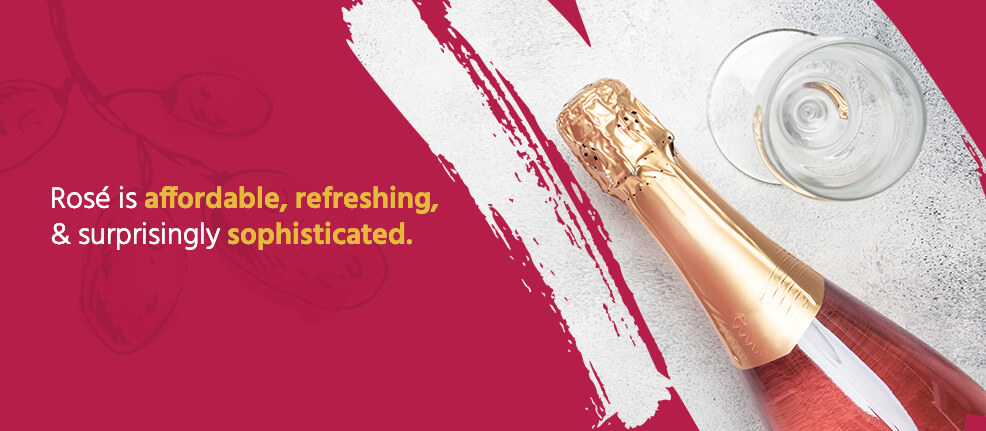
What Is Rosé Wine?
Rosé is a pink wine with the lightness of white wine made from a variety of grapes. The concept may be a bit confusing to the novice, as wines tend to fall into one category or the other, and leads to some skepticism from wine snobs and the pink-averse alike.
Rosé can be a dry or sweet wine that tastes similar to many white wines and offers a bright, more refreshing flavor than its deep red counterparts, making it the perfect sunny day drink on a Sunday afternoon or when you’re in the mood for something lighter.
Unlike Champagne or Burgundy, Rosé can be made with any grape from any region and is made all over the world — the United States, Spain, France, Italy, Australia and Chile all produce this type of wine.
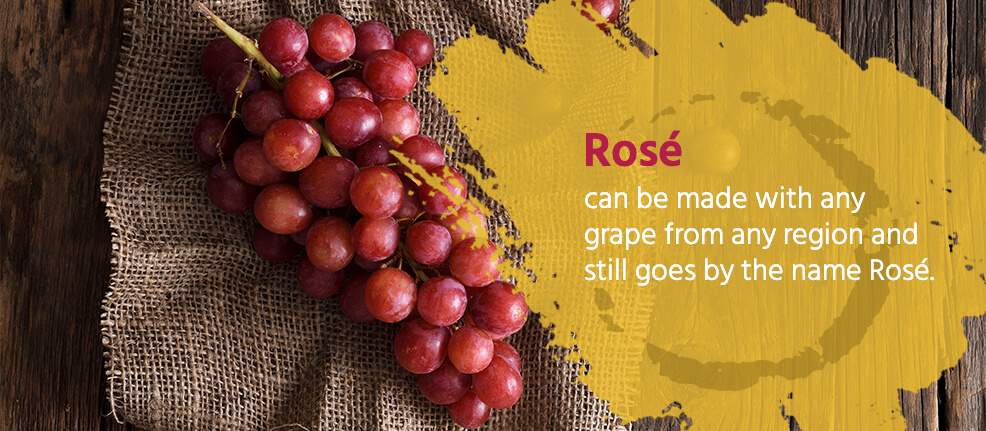
How Do You Make Rosé Wine?
Contrary to popular opinion, Rosé wine is not a blend of red and white grapes.
Most of the time, Rosé wine is made exclusively from red wine grapes. These grapes have red skins, but the insides are white, meaning you can create a broad range of wines ranging from white to deep red.
The red wine grapes are slightly crushed before the fermenting process begins so the skins and the insides have some time to ferment together. Depending on the type of wine, this process can take as little as a few hours to several days.
At this point, the juice, and the solid skins and seeds, which are known as the must, are separated, and the juice is placed into tanks for further fermentation. As you might imagine, the longer the skins sit in the grape juice, the darker the finished wine will be and the more tannic the flavor.
In some rarer cases, Rosé is made by mixing white wine with red, but this is generally only used in low-quality or sparkling wines and by no means should be considered the standard.
Rosé, Three Ways — A Few Different Approaches to Pink Wine
Rosé wine usually is made one of three ways — all of which involve some initial contact with the grape skins as mentioned above, but they diverge slightly in their path from the tank to the bottle, depending on what type of Rosé you are trying to make.
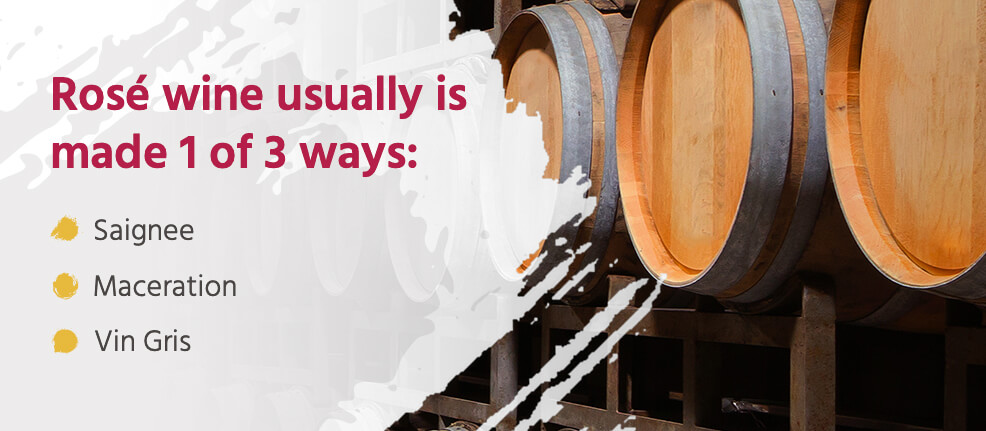
Here’s a look at the more conventional approaches to how the Rosé is made:
1. Saignee
Saignee approach has been used to produce some of the longest-lasting Rosés around. This method is a by-product of making red wine. About 10% of the grape juice is bled off during the fermentation process of red wine. For the red wine at hand, this means there is a higher skin-to-juice ratio in the tank, leading to more contact with the grape skins, more tannic flavors and a richer bodied flavor profile.
The bled wine is then fermented into a Rosé, albeit a much darker version than most Rosés you’ll find on the market.
2. Maceration
Maceration is the most common method for making Rosé wine and refers to the point in winemaking where the grapes are pressed and then left to sit in their skins. When you make red wine, the grapes stay in their skins throughout the full fermentation process. In the case of Rosé, the juice and skins must be separated before the resulting wine becomes too dark.
Rosés made from lighter-colored red grapes like Grenache take upwards of a full day, while darker-colored grape skins may only hang around with the juice for a few hours.
3. Vin Gris
Vin Gris is French for Gray Wine, and this method of making Rosé refers to making wine that is almost white. This process uses the maceration method but shortens the time grapes sit soaking with their skins to under a few hours.
Wines like Pinot Noir Rosés, as well as other lighter varieties, are made this way — which offers an additional benefit — the grapes can still be used to make another red wine. An economical method for wine makers, to be sure.
Hitting the Right Notes — What Does Rosé Wine Taste Like?
The pink color is what most identifies Rosé wines, but there’s so much more complexity to these wines than just their shared rosy hue.
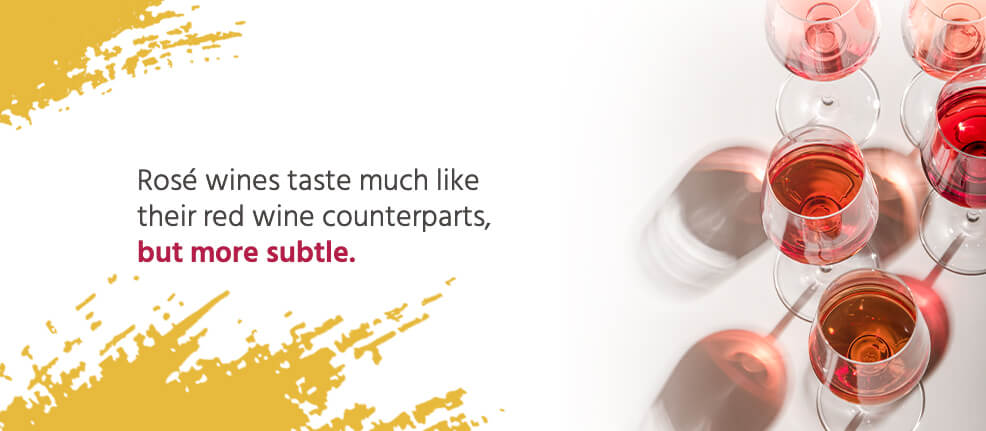
In general, Rosé wines taste much like their red wine counterparts but are more subtle. In general, expect to get some notes of citrus, watermelon and a range of berries. Wines can range from super dry to very sweet and floral, and certain Rosés boast big, bold, meatier flavors or hints of spice, while others are cool and crisp or sweet like candy.
Dry Rosés
Dry Rosé wines have a low sugar content and high tannins. While they could be described as simply “less sweet,” they are best described as being slightly more bitter with a dry finish. This is similar to the tannins that give that signature bitterness and astringency to wines, teas, coffees and chocolates.
Dry Rosés are typically made from French, Italian or Spanish wines like Grenache, Tempranillo or Pinot Noir, though there are some exceptions.
Sweet Rosés
Sweet Rosés are a bit more complex than that large box of white zin hanging out in your grandmother’s kitchen cabinet. “Off-dry” wine is relatively sweet, but it falls between dry and sweet on the scale of wine sweetness, making for a palatable sipper that’s sure to hit the spot any day of the week.
Sweet Rosés offer more in terms of versatility than their dry counterparts. They bring a sense of balance to bold foods, rather than being overpowered by spices or rich flavors.
Rosé Wine, A Brief History
Like many great wine stories, the Rosé story begins in France. The first French vineyard was in Provence, established when the ancient Greeks brought grapes to the South of France, sometime around 600 BC when they founded the city of Marseilles.
At this time, the Greeks were drinking wine, but most were as pale in color as the Rosés you’ll see on the market today. It’s likely the reason the first wines of Provence were Rosés rather than reds or whites is that the process of maceration had yet to be fully understood.
While Rosés are trending currently, many people don’t know that Rosé is one of the oldest wines around and, interestingly, has maintained a high level of popularity throughout the ages. Even with the Roman introduction of red wine centuries later, Rosé production and consumption held steady.
In the Middle Ages, long after the fall of the Roman Empire, monastic orders kept producing Rosé, a longtime staple in Provence, as a key revenue source for local abbeys.

Up until the birth of the railroad, Rosé stayed relatively contained to Provence, but the industrial revolution soon gave way to a greater fan base. Tourists could now access the famous pink wine, and imports were on the rise, sending Rosé to all corners of the globe.
Rosé All Day — How Pink Wine Became a Lifestyle Symbol
While Rosé has never really gone away, it’s also never been synonymous with sophistication in the same way as a high-end red wine. Rosé has long been a symbol of refreshment due to its subtle taste. While it doesn’t tend to get better with age — there are exceptions, but for the most part, there’s no real advantage to getting an older bottle.
Over the past ten years, there has been an uptick in Rosé consumption in the US. As the sale of cheap pink wines began to fall, Americans began to develop a taste for dryer Rosés, as many American tourists started bringing Rosé back from their travels in the South of France.
As the darling of social media and wealthy Hamptons vacationers, Rosé has become a lifestyle trend of sorts, promoting an ideal of luxury — summering with a glass of refreshing Rosé in hand.
Types of Rosé Wine — Yes, There’s More Than One
While the common misconception is that all Rosés are the same, this statement couldn’t be further from the truth. There are a few different types of Rosé wines, and the major difference here is which variety of grapes are used as the base. Some Rosé wines are sweet, while others have more challenging flavor profiles.
While it’s possible to make Rosé from almost any kind of red wine grape, some grapes are more known for their pinks than others.
To show that all Rosé wines are not created equal, here’s a quick look at the personalities of some of the more popular types of pink wine, along with recommended Rosé wine pairings:
Grenache Rosé
One of the most common sources of Rosé wines around the world, Grenache, or Garnacha, grapes produce this lovely strawberries and cream combination when made into Rosé. Drinkers will delight in low-key red raspberry and black cherry, and in some cases, hints of cucumber.
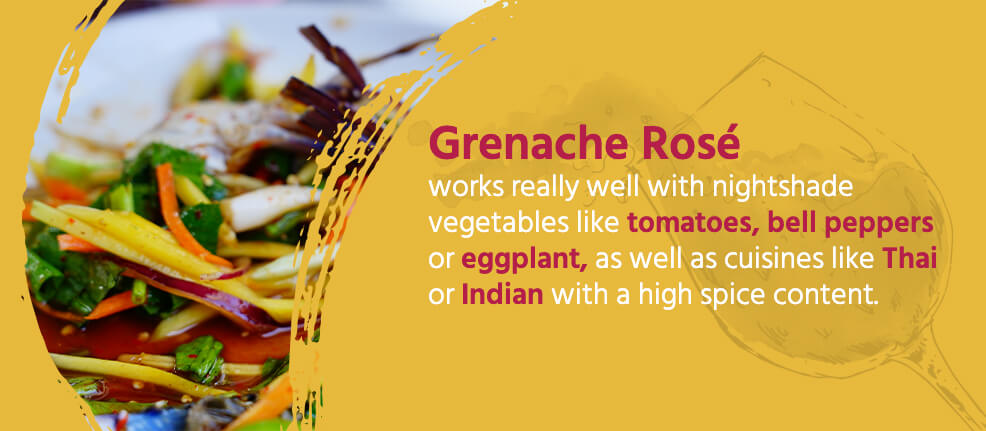
Pairings: Grenache Rosé works really well with nightshade vegetables like tomatoes, bell peppers or eggplant, as well as cuisines like Thai or Indian with a high spice content.
Sangiovese Rosé
A little bit spicy with cool weather spices like cloves, cinnamon, and allspice, the Sangiovese grapes offer a combination of melon and strawberry notes, finishing with a hint of mineral. This Rosé is both clean and acidic, perfectly refreshing on a hot day.
Pairings: Sangiovese Rosé is great on its own, given the variety present in the glass, yet it goes with just about any type of food. Hailing from Italy, Sangiovese works perfectly with Italian meats like prosciutto, salami and pancetta, so it works well alongside any cheese board. This Rosé also works well with curries or Chinese food since the bold blend of flavors keeps it from getting lost in the richness of the cuisine.
Tempranillo Rosé
This Spanish wine offers a mix of fruity notes like strawberry and watermelon, as well as peppercorn and an overall rich flavor added to the mix.
Pairings: Tempranillo Rosés work really well with grilled or roasted vegetables, meats and more. Though most Rosés are already super versatile, Tempranillo Rosé is perfect for bringing out during grilling season as it can stand up to the hot dogs, steaks and burgers served at your classic cookout.
Pinot Noir Rosé
Easy drinking, Pinot Noir grapes offer subtle yet zesty citrus, melon, cherry and celery notes in one glass. Dry, yet delicate, Pinot Noir Rosés are full of flavor but bring a gentleness to the table.
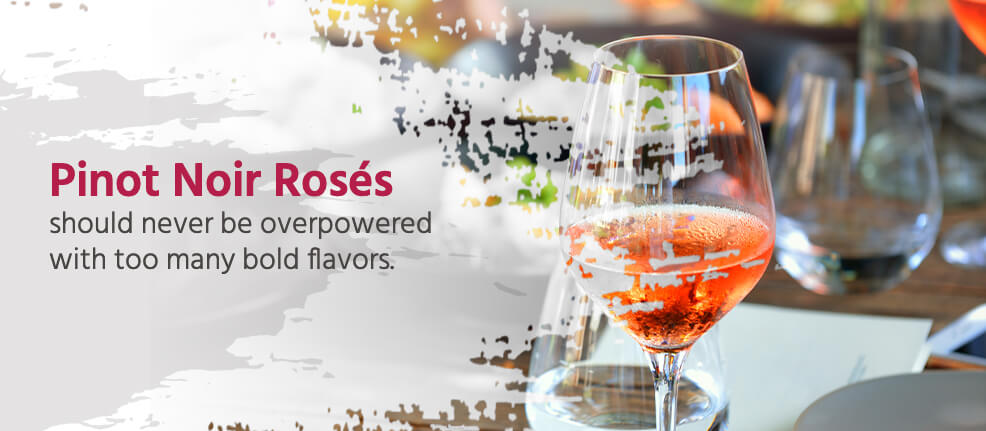
Pairings: Great with floral spices like thyme or tarragon, Pinot Noir Rosés should never be overpowered with too many bold flavors. Think grilled chicken or fish seasoned with herbes de province, corn chowder or any number of seasonal summer salads with fresh greens and a mild dressing.
Syrah Rosé
This particular grape makes for a lovely rich Rosé. Syrah-made wines offer hints of red and white peppercorns, cherry and even the smokiness of a cured meat topped off with a zesty lime finish.
Pairings: Syrah Rosé works best when it stays within the cuisine of its origin. Southern French or Italian cuisines really make this relatively meaty pink wine sing. Think of flavors like garlic and citrus, roasted vegetables, shrimp linguini and so on.
White Zinfandel Rosé
Also known as Zinfandel Rosé or White Zin, this is one of the most popular varieties of Rosé, especially in the United States. With its “off-dry” style, this wine is on the sweeter side, featuring notes like melon, lemon and strawberry with a little cotton candy thrown in for good measure.
Pairings: Best served cold as ice, White Zinfandel can take on bold flavors like Thai spices and curries, as well as fatty savory meats. Sometimes opposites attract.
While Rosés are one of the more surprisingly versatile wines on the planet, skip the dessert if you’re looking for a winning pairing — no matter what variety you’re sipping on. Sweet foods might highlight the taste of the alcohol in the wine, making it fall flat or taste bitter.
In general, sweet Rosés are versatile. They help balance out hot and spicy foods or tone down saltiness.
Rosé Cocktail Hour — Mix it Up with Pink Wine
What’s better than Rosé straight from the bottle? Drinks made with Rosé wine! With their nuanced fruity notes and sweet pink color, nothing is more effortlessly festive than a Rosé cocktail served with a garnish in an ice-cold glass. Plus, there’s room for experimentation — Rosé is relatively inexpensive, so you won’t have to worry about wasting fine wine.
Here are some of our favorite Rosé wine cocktail recipes, which are sure to impress all your friends at your next dinner party or group hang:
Rosé Wine Cocktail Punch
It’s time to reclaim punch. Maligned as a questionable school dance staple, the punch bowl has a bad rap. However, with some Rosé wines, fresh fruit and a splash of vodka, this grown-up fruit punch is king among big-batch party drinks.
Ingredients
- 2 bottles of Rosé wine
- 2 cups of sliced and washed strawberries
- 2 cups blackberries
- 2 cups raspberries
- 2/3 cups of vodka
- 1/3 cup of vanilla liqueur
- 2 cups of sparkling water
Instructions
- Fill a punch bowl Rosé, vanilla liqueur, and vodka. Mix thoroughly.
- Then add fruit and sparkling water.
- If desired, serve with ice on the side, so the punch doesn’t become too watery.
- Enjoy!
Rosé Margarita
A lighter, and let’s face it, more grown-up version of your basic margarita, this Rosé cocktail is the perfect summer sipper complete with fresh lemon, pink wine and, of course, tequila. This recipe yields one cocktail, but you can always multiply the recipe and place it in a glass pitcher for guests.
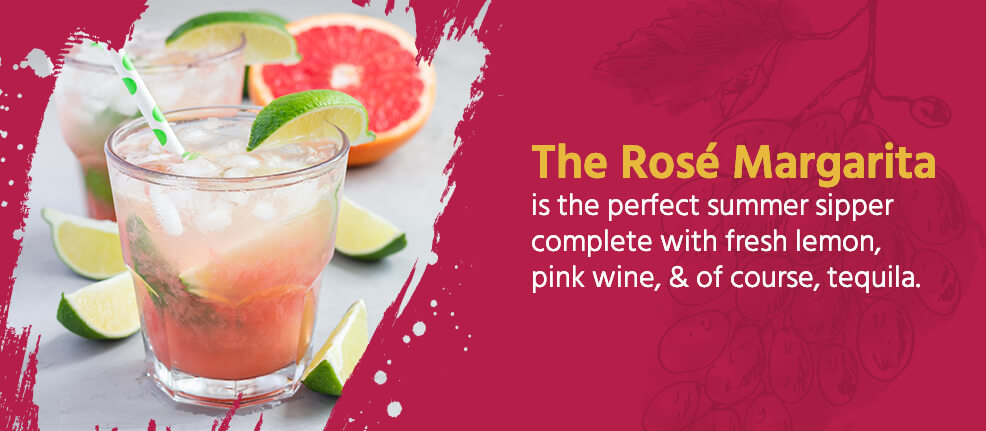
Ingredients
- 2 ounces of Rosé
- 1 ounce of tequila
- 1 ounce of freshly squeezed lemon juice
- 1 tablespoon lemon zest salt-sugar for garnish
Instructions
- Put together the garnish. In a small blender or food processor, add lemon zest, salt and sugar.
- Blend until all ingredients are thoroughly mixed and set aside in a small, shallow dish.
- Fill a shaker or pint glass with ice. Add the tequila, Rosé and lemon juice, then shake.
- Press the rim of your serving glass into the salt mixture, then gently pour the margarita mixture into the glass.
Grapefruit Herb Rosé
Let’s dress up that Rosé! Delicious grapefruit and orange liqueur take your basic Rosé champagne — although we do hesitate to call it basic — up a notch. This easy cocktail is the perfect accompaniment to any egg-centric brunch or the first cookout of the year.
Ingredients
- 3 ounces of Rosé champagne (chilled)
- 1 ounce of orange liqueur
- 1 ounce of grapefruit juice
- 1 tablespoon of basil, muddled
Instructions
- Place basil leaves in the bottom of a pint glass or shaker tin.
- Muddle the basil by pressing firmly on the leaves with a muddling tool and gently grinding the herbs. This process helps break down the chlorophyll, which may leave a bitter taste behind.
- Add orange liqueur and grapefruit juice to the same container as the basil and shake or stir vigorously.
- Transfer muddled mixture to serving glass and pour Rosé champagne over the top.
- Garnish with a lemon slice or additional basil, if desired.
Rosé FAQs
Do you want to learn more about Rosé? Below are some of the most common questions we receive — and answer — about Rosé wine. If you have another question, feel free to reach out to our team.
What Kind of Wine Is Rosé?
As described above, Rosé is a pink wine, though it has white wine’s lightness. This type of wine can be made from a variety of grapes, as what sets the pink wine apart is the time it ferments with the grape skins — Rosé is taken out of the fermentation process earlier, which gives this variety its pinkish hue instead of the traditional deep red. This difference in the fermentation process also gives Rosé a lighter flavor.
What Does a Rosé Wine Taste Like?
Rosé is equally lighter in color and taste. When you take a sip, you may realize that this wine is a bit crisper than traditional red wines. This effect is due to its natural notes of citrus, watermelon, berries and rose petals. Rosé’s taste can vary significantly — from sweet to spice — so you can try several options to find a flavor that fits your preferences.
Is Rosé Wine Sweet or Dry?
The beauty of this wine is that it can be sweet or dry, often depending on its country of origin.
More traditional Rosé wines from Europe will be on the drier side as they are made with high tannins, which are derived from the fermenting red wine grapes’ seeds, stems and skin. However, you can still enjoy this variety if you have a sweet tooth. Modern Rosé made in the United States tends to be made with more syrup, creating a sweeter flavor that makes the wine more versatile.
Is Rosé Wine Sweeter Than Moscato?
In short, yes and no. Moscato is a white wine that is almost always on the simpler and sweeter side. Rosé is a red wine with a higher degree of variety in its flavor profile. It is possible to find a version that is close to a Moscato in sweetness, but as a red wine, Rosé will typically have drier, more complex notes.
Is White Zinfandel the Same as Rosé?
White Zinfandel is under the umbrella category of Rosé but has its own distinct flavor profile. Rosé can range in its flavors as it can be made with any red wine grape, but White Zinfandel is unique because it is made with specific Zinfandel grapes. This distinction makes White Zinfandel a type of Rosé wine.
Thirsty Yet? Get Your Rosé Wine Fix at Marketview Liquor
Rosé is one of the best deals out there, and exploring the different types is one of the best ways to find your favorite. At Marketview Liquor, we’ve got a full range of Rosés from dry to sweet and slightly bubbly — perfect for brunch, grilling out, or a summer night on the patio.
Enjoy a wide range of Rosé wines at every price point and style with shipping across the United States. If you want to try out a variety of different brands and types, check out our mix and match case discounts on select wines. In addition, we offer free shipping on select bottles when you buy six or more at a time.
In the Rochester, New York area? Order online for in store pickup, or visit us in the store.

